Let’s Talk Graffiti and Sustainable Development
Video games have become so immersive in the ways we can interact with non-playable characters and the fictional worlds that they live in. We have always imagined what it would be like to stand alongside our characters and carry out their quests with them. It also has influenced us to imagine living a life and doing every day activities from the comfort of our homes. These ideas have contributed to the development of virtual and augmented reality. Using our phones and/or special virtual reality headsets, we have been able to transform the space around is and create simulations of products and worlds that we can interact with from our own points of view. Many people are familiar with virtual reality games such as Beat Saber (2018) and Superhot (2016) where the space is altered around us and objects are flying towards us. Average people are even capable of making their own virtual reality spaces to share with people and we can meet people online in our own avatars. Using virtual reality, we can now make our online connects even more personal. It is even used for educational purposes like viewing simulations and models of space, the human body, and walkthroughs of museums. But how else can virtual and augmented reality be used to make an every larger impact on the outside world and people we meet? Well I believe that is possible with Kingspray Graffiti VR (2019), a virtual reality game that allows you to spray paint graffiti at several different locations. You may be asking, how can a simulated illegal activity help to spread any sort of positive world messages? First, let’s hear from graffiti artist Gabe Gault.
Gabe Gault was asked by the creators of Kingspray Graffiti VR and to walk us through his process on how he creates work using spray paint. He typically is commissioned to create large wall murals, but in this video he is showing that same process in this virtual landscape and explain his artistic and creative decisions. His final result was meant to be his interpretation of the future of exploration, depicting a woman of color as an astronaut. In this short 3 minute video, he is able to convey such a simple and meaningful message through graffiti. While graffiti does have a negative connotation, it is important to understand how graffiti has not only transcended into a valid and sought after art form and style, but has also been around for centuries.
Why Does Graffiti Matter?
Graffiti is loosely defined as the vandalism of public property, typically using paint or other mediums that alter the surface in an artistic or creative way. The content itself does not necessarily need to be “offensive” or “gang-affiliated” or have that specific organic style to be considered graffiti. The difference between graffiti and a mural is that the artist is given permission to create the mural. But then why do we still refer to it as graffiti if it is legal? Its because graffiti, historically, has always been so much more than just vandalism and because of its long history, “Graffiti” has developed into a style of art and an art form itself. The earliest known graffiti is cave paintings. Depictions of hunts and prehistoric animals on what would be considered public cave walls. From back then to the present, graffiti has always been used as forms of record keeping, decorating, rebellion, and propaganda. Graffiti has contributed to much of what we know about those who came before us. Graffiti has always been a sign of civilization, its good and its bad parts. And that has not changed. Overtime, urban areas developed a bubble lettered, organic style of graffiti that was often associated with gangs and violence. But tags and messages placed by those in modern cities serve no different purpose than those of our ancient ancestors. But because the style has changed to something so much more bold and bigger than older graffiti, people began to take even more offence and to stand against it. That is not to say we should be supporting messages of violence, but the purpose of graffiti has always been to share a message. And if people are not listening, then graffiti artists will make their messages so you cannot ignore them. And because of this constant pushing by graffiti artists to be seen and by others for them to stop, that is how we have developed graffiti into this very vibrant art style that is so sought after. Graffiti has always been done to convey a message, now we just know how to do so more clearly with citizens and corporations having taken part in this process.
(Please view the TEDEd link to learn more about the history of graffiti and its historical and cultural significance.)
Sustainable Development Goals Graffiti Projects
SDG Street Art (2020)
As mentioned, graffiti (also known as street art) has always been done with the purpose of conveying some sort of message and it has developed into an art form used by many large organizations. The United Nations’ Sustainable Development Goals have been the influence of two graffiti based projects. SDG Street Art was an event held in Cork City, Ireland where participants were able to spray paint images and messages related to the 17 SDG’s on a public wall (with permission of the city to do so.) The purpose was to spread information about what the SDG’s are and gain more attention for the global project.
Mongolia Graffiti Art Campaign (2017)
Another graffiti project was a campaign done in Mongolia by a single young artist, sponsored by the Global Goals Organization. This artist painted his interpretation of each of the 17 goals on the walls outside of Mongolia’s United Nations House. Again, the purpose was to share these global goals with their community and gain more attention to all of the goals and causes being targeted by the United Nations.
How Students Can Use Graffiti to Spread a Message
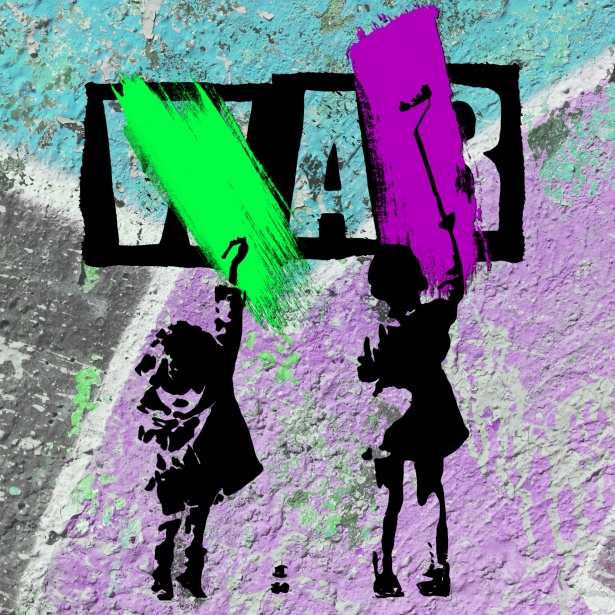
These next ideas can be done by anyone of all ages, but I came up with these ideas coming from the mindset of an aspiring art teacher. Because graffiti in many cases is illegal and it takes special permissions to be able to create public murals which are very difficult to get, I want to consider Kingspray VR as an alternative and a foundation for something greater. Let’s say students were to pick an SDG and target they felt strongly about or another cause and they used the app, individually or collaborative, to create virtual graffiti murals that represent and promote their chosen cause. It is a fun and unique way for students to create meaningful work while also incorporating new technology into the classroom. If we wanted to expand their projects and share them, while again it would be difficult to get a sponsor to want to have students work blown up and plastered on public walls, it can be blown up and plastered in schools. Imagine a graffiti art show where all of the art they created in virtual reality was downloaded and displayed all around a school gym or auditorium. Or if they were used to cover walls or bulletin boards around the school. Or if you wanted to use even more technology, you could consider developing it into an augmented reality art show where their graffiti pieces are turned into AR model that can be scanned on devices and viewed in the real world on a blank wall through a smartphone or tablet. And I understand that for many schools it would be difficult to give many students the opportunity to create full pieces of work in virtual reality, but it can even be altered to them practicing in virtual reality and creating sketches and then painting them on large pieces of news print of bulletin board paper.
I think virtual and augmented reality, more specific Kingspray VR, as well as graffiti can be used to spread very powerful messages and can be developed into unique expansive projects for anyone. I do believe it is worth considering and checking out for yourself.
DOWNLOAD KINGSPRAY GRAFFITI ON OCULUS QUEST TO SHARE YOUR OWN MESSAGE!
Thank you for reading!
Follow me on Twitter at @IreneOrtiz001
WE Learning Resources: Visual Arts and Community Outreach
Have you been looking for ways you and your school community can make a larger impact on our world? Are you looking for ways to promote global sustainability and inclusivity while also staying true to your content area? Well, look no further than WE.org. WE is an organization that helps classrooms around the world expand their volunteering efforts beyond their school communities. They provide resources such as videos, conferences, lesson plans, events, grants, and so much more in order to help you and your students achieve your goals.
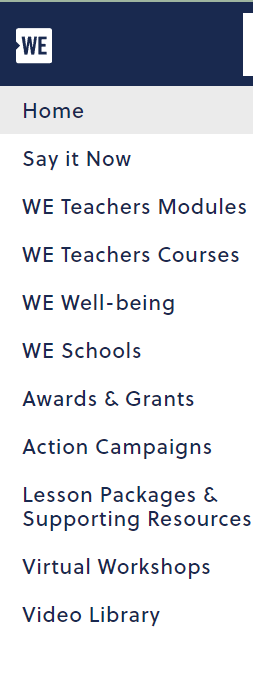
Using their Virtual Learning Center, educators can find lessons and professional development courses that will help them provide the education they need to students about ways they can get involved and why they should. They focus on several global sustainable development goals including things such as hunger, waste clean up, and equity. There are lists of several campaigns for classrooms to get involved in. Or you can view their lesson plans and modules to learn about a specific goal or volunteer effort and you and your students can develop your own campaigns. Through this site you can also get grants to support your campaign and expand your outreach. All of their resources range from kindergarten to the high school level, so it really is for everyone!
As a future art teacher, I wanted to find lessons or campaigns I could use in my classroom where students can use the visual arts to help promote or be a part of any cause they had to offer. I was able to find a couple of lessons that I could see myself using in the future as ways to get my students involved.

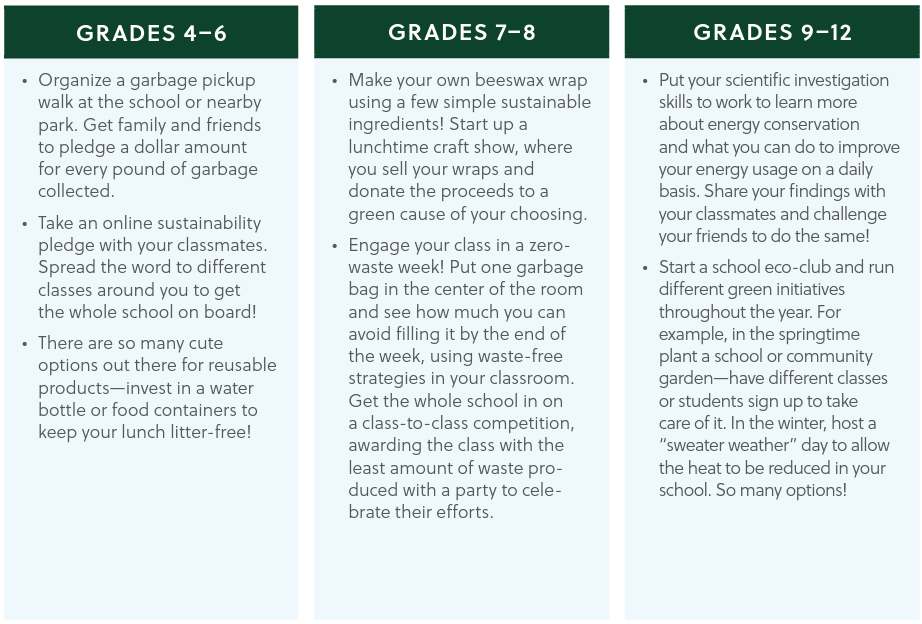
We Go Green is a campaign outline that guides teachers through teaching students about waste and recycling. At each grade level, students will learn statistics about waste and recycling and come up with plans on how they can promote having a green thumb or how they themselves can help contribute to reducing waste.
Students individually or in groups can make their own goals and come up with a plan to achieve them. Then they can give themselves jobs within their campaign for how they will help to complete their goals. I thought this was interesting for an art classroom because not only can they create beautiful posters and works of art that promote recycling and reducing waste, but they can also use the waste!

By collecting trash and recycling from around the school, home, and in their communities, they can repurpose this trash to make works of art that are representative of the cause. I could even see myself planning an art show within the school to showcase the work. The event would showcase student work and display how many pounds of waste they were able to upcycle to create their work. And on a larger scale, we could possibly even turn it into a fundraiser!


Understanding Local Hunger is a unit plan on WE.org that teaches students about hunger and low resources on a local to global scale. Throughout the unit, the teacher will guide the students on learning about hunger, analyzing the statistics, coming up with possible causes, and then creating and developing possible solutions. These lessons come in all grade levels. However for the purpose of talking about how I would use this resource, I am focusing on the high school unit. These lessons are fully developed including the common core standards, objectives, resources, and procedures for each lesson. The structure for each lesson unique and caters towards all types of learners and works across all content areas. These lessons pull from math, science, English, history, and the visual arts in order to create a dynamic unit that fully encompasses everything students would need to know before developing their solutions.
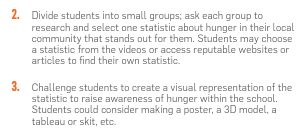
Lesson 5 is specifically what I want to focus on since it involves media. In this lesson, students would have to use any art form, digital or traditional, to create a visual representation of a statistic about hunger.
I think this is an amazing lesson and project that I could have them do in groups for two to three days or individually over the course of a few days. In addition to teaching them about hunger and why it is so important, this would also be a great time to teach them about how visual media can display messages and create an atmosphere or certain perception of their subject. We could also tie in a lesson about symbolism and how certain symbols or aesthetic choices can change the meaning of your work. We could view examples of works by famous photographers, painters, and graphic designers that depict hunger and its impact on society. Students can gain inspiration about how to convey their message and statistic and use what they have learned to create their visual representation. Again we can even share these on a larger scale in an art show or online gallery!

As mentioned, if I were to pursue these projects, I would want my students to be able to share their work on a larger scale and make the greatest impact. I would want my students to understand how art can impact people and promote and messages that are important in ways that sometimes words cannot only describe. Therefore, I could reach out to WE.org and apply for their action grants such as the Heartwarming Project. Through this grant we could receive some funding that could help is in sharing their hard work outside of our school community by creating a larger event where we can to donation drives, fundraisers, recycling program, and so on. WE.org is truly a great organization and is something I will heavily consider looking into more in the future when I have my own classroom.
CHECK OUT WE.ORG FOR MORE INFORMATION ON HOW YOU AND YOUR STUDENTS CAN GET INVOLVED!
Thank you for reading!
Follow me on Twitter at @IreneOrtiz001
Vatican Museums: A Virtual Tour
The Vatican is not only a home for the followers of the Roman Catholic church, it is also home to several historical Italian Renaissance pieces. It is within the frescos and statues of this holy building where artists conceptualized the complex ideals of this time period. Despite its location, these works best represent the interest in humanism founded in the High Renaissance, an understanding and appreciation of the needs and achievements of humans rather than just a divine power. Artists were commissioned to create works and paint on the walls of the Vatican and Sistine Chapel, famously including Raphael and Michelangelo. Now these idealized, Greek-inspired forms are open to the public to see, but not everyone will have the opportunity to walk into a room and be consumed by the artist of some of the greatest Renaissance. However, the age of virtual reality and 360 degree cameras have solved this problem! Now with Musei Vaticani you can take a virtual tour of 14/26 museums within the Vatican in a 360 degree interactive tour and whatever you cannot see virtually, you can enjoy in a video from the same place!

What Can You See in These Virtual Museums?
- Raphael’s Rooms
- Visit the four rooms of Raphael, painted from floor to ceiling in his fresco paintings. Even take a look at one of his most better known pieces, The School of Athens. Get up close, without the risk of chipping the old pigment, and examine how Raphael is able to capture the complexity of the High Renaissance by depicting some of the greatest philosophers, mathematicians, historians, theologists, and writers of his time and the consideration of the living and the spiritual.

- The Sistine Chapel / Sistine Halls
- Engulf yourself in the ceiling high frescos of the Sistine Chapel. Several works by several artists commissioned by the Popes of the era. The work in the chapel is meant to commemorate significant religious figures and events.You can even view the famous Sistine ceiling painted by Michelangelo where he illustrated 9 stories of the Genesis including The Creation of Adam.

- New Wing
- The New Wing displayed sculptures that were originally taken by Napoleon and in an effort to honor the artists and historical significance of these pieces, the entire wing was decorated with traditional tiles, architecture, and reliefs similar to those of the time period when these works were created. A majority of the statues present in the wing are replicas of Greek statues, who were big inspirations to Italians of the era, and emperors.

- Pio Clementino Museum
- These halls are filled with ancient and classical collections of sculptures that were excavated, collected and or donated to the museum in an effort to restore and protect antique works of art of Italy. The halls are embellished with Neoclassical decorations overseen by several artists whose works are already displayed throughout the Vatican, including Michelangelo.

- Salone Sistino
- I could not find information on their website or much online about what is within the Salone Sistino, but to my understanding it is or was a library and possibly at one point the Pope’s private study that has been in and out of the public eye for several decades now. The virtual tour oddly did not load properly for me. Let me know if it worked for you in the comments below!

- Profane Museum
- A collection of several items whether their origins are unknown, are from before the Roman era, or are not about religious topics. Essentially, this museum is about anything other than religion that is found to be important enough to conserve,

- Pauline Halls
- Pauline Halls is a chapel where the last two painted ever created by Michelangelo stand. The Conversion of Saul and The Crucifixion of Saint Peter, two frescos on opposite walls from each other.

- Chiaramonti Museum
- This site is home to several Roman antiques like many of the other museums, but this museum is home to several busts used for funerals and as commissions of royalty, soldiers, and the wealthy.

- Hall of the Papyri
- Unlike other areas of the Vatican, this hall displayers terracotta works and decorations which suggest ancient Egyptian influence by artists from the 1700’s.

- Niccoline Chapel
- A hall full of several frescos of religious figures and murals with heavy depictions of the humanism philosophy.

- Gallery of Urban VIII
- This chapel within the Vatican includes frescoes that depict the Stories of the Passion of Chirst commissioned to be painted by Italian artist Alessandro Vaiani and possibly alongside him was his daughter. Also includes paintings where the bases of the walls were made with leather, not as common of a practice at this time.

- Alexandrine Hall
- Again I could not find much information on the works and decorations in this hall, but I assume they are extensions of other rooms within the Vatican and are covered with frescoes by some of the several artists that have laid their hands on the walls of the Vatican.

- Room of the Chiaroscuri
- Another room with Raphael’s touch, this room depicts several statues of Apostles and Saints whose appearances were clearly heavily Greek influenced, as expected. These paintings would be touched up by other artists in the 1500’s.

Overall, I think this is an amazing website and for the most part the virtual tours and videos are great quality and provide basic information about every collection that is viewable. You can even order tickets for guided virtual tools, so if that interests you make sure to click any of the links in this blog to get to the website and start your tour of the Vatican. I hope you will like it as much as I did!
Thank you for reading!
Follow me on Twitter at @IreneOrtiz001
Train to Busan: A South Korean Horror Film
SPOILERS WARNING: If you would like to watch Train to Busan before continuing to read this blog, follow the link HERE to watch on Youtube for free with ads. It is in Korean with English subtitles.
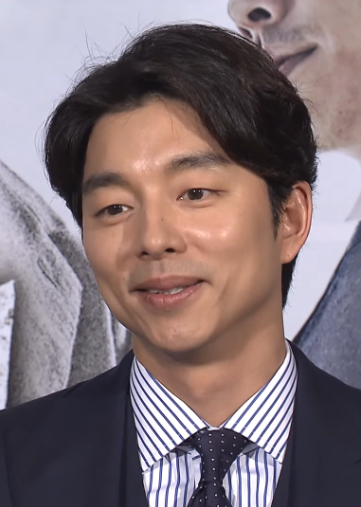

Train to Busan is a South Korean zombie horror film where the main protagonist Seok-woo, portrayed by actor Gong Yoo, is trying to reclaim the trust of his daughter while trying to lead her and survivors to safety during a virus outbreak. The title stems from the fact that Seok-woo and his daughter Su-an are taking a train to the city of Busan for Su-an’s birthday to go see her mother. Those infected with the virus have overrun many major cities and conveniently, the only city that has not been shut down by the military or overrun by zombies is Busan. Throughout their journey, each train and train car they enter continues to get overrun by the infected. They have to continuously fight their way through the trains, losing many survivors along the way and trying to survive until they reach Busan. It is a very intriguing film compared to many American zombie and/or horror films due to its unique conflict and its creative takes in regards to filming. I do not typically watch shows or movies that are not in English, not for any particular reason, it just never occurred to me. Therefore, I will be using Train to Busan and compare and contrast its story, character’s personalities and values, and cultural aspects to that of American films.

As mentioned, this movie takes place is Seoul, South Korea with their final destination being Busan. The map above shows more or less what the route they would have taken looks like when taking the KTX train. They even consider other cities on this map such as Daejeon as possible safe places. The route to Busan is approximately 2 hours and 15 minutes long, and the movie itself is almost two hours long. Unlike many American movies I have seen, especially American horror movies, these types of situations typically occur over the course of days. Gradual outbreaks. For the creators of this film to have the main conflict unfold over the course of only a few hours and having the film be about the length of the normal train ride to Busan, it really adds to the urgency and stressful atmosphere created in the film. That said, while the main setting of this film does take place within a train, they do make stops in train stations and pass through major cities along the way where every time they are surprised by the lack of people and then attacked by masses of the undead. This tells us not only how densely populated these cities are, but also how frequently train is used to travel from one city to the next. In each train they enter, or rather try to enter, they are bombarded by dozens of zombies in each train car and in the beginning of the film when they first get on the train before the outbreak occurs, the train was already packed with passengers and there were others waiting to get on. In America, while trains are available for travel, it is not a common form of travel and our railroad network is mainly used for freight trains. The New York City subway is definitely more likely to be packed similarly to this rather than a regular train even in a densely populated city.
Security is lacking on these trains. In the beginning of the film we see two people sneak onto the train. One is a girl who was just infected and the other is a homeless man. The girl was able to jump on quickly when the train conductor turned around. The homeless man was hiding in the bathroom which the young daughter Su-an comes to see. No one tells her to return to her seat for her safety. She also continues to move through each train car with no supervision. However, I am going to assume this is to push along the plot of the movie and have us further understand just how careless and absent her father is and that this lack of safety is not actually practiced.

The social dynamics and values present in the film are actually not so different from what can be seen in America. The main character, Seok-woo, is a father who works an office job as a funds manager. He just recently separated from his wife and they are splitting time with their daughter Su-an. However, Seok-woo is rather absent in his daughter’s life due to how demanding his job is and that is introduced through the fact that he is unfamiliar with his daughter and her interests and him missing her school events. His mother who lives with him even gives input to the situation, saying that he should focus less on his working and focus more on fixing his marriage for his daughter’s sake. The depiction of these struggling nuclear families are very common in American television as well considering it is something that many who watch can relate to. We see this in popular television such as The Walking Dead, a zombie horror series where Rick Grimes, father of Carl and husband to Lori, is attempting to rekindle the spark with his wife and protect his family and others during a zombie apocalypse. His relationship to his family often suffered due to his work as a sheriff’s deputy. Both Rick Grimes and Seok-woo are faced with the reality of their situations and completely turn around and become strong and better men in order to protect their families, even if it puts their own lives at risk. They become characters that we cheer for because of their determination and courage to protect their families, as many of us would hope we would be able to do in times of crisis.
Throughout the film, women and children are made a priority to get to safety. Besides the young girl Su-an, there is also a teenage girl, a pregnant women, and two older women who are sisters. Throughout each seen, all of these women are shown a lot of care and respect. They are offered seats on the trains and Su-an even offers her seat to one of the older women. Both the older and pregnant woman offer Su-an a hard boiled egg and a Korean snack. When the survivors are being attacked, the women and children are made a priority. The men are either in front of them leading the way or left behind to fight off the undead and push the women and children forward. Of course there were selfish people throughout the film, but that is to be expected in any case. This is a social value that is shared in America as well. Women, children, and the elderly are often made a priority and we see this especially in films. However, I will say, especially in the present day, we are seeing women take on more traditionally male roles in films. Referring back to The Walking Dead, we see a character named Andrea demand to help the men protect the farm they are staying at and be taught how to use guns while the other women worked on providing stability with cooking and cleaning. As the series continued, the women began to take on leadership roles in their newfound communities. I am curious of any of the other movies in the Train to Busan series have women take on more leadership roles. The only time where we really see a woman take charge in the film is right at the end where it is just Seok-woo, Su-an, the pregnant woman and a zombie and the woman pulls the zombie off of Seok-woo in an attempt to help.
As we see in this film and in many others from other cultures where chaos insus, initially everyone is concerned about their own safety. Everyone is watching the news on the television screen on the train or looking at news outlets on their phone, and while the media is telling them not to panic, they are living in fear of what is to come and the images and videos being played are scaring them more. Many of them begin to panic and turn on each other or only lookout for themselves. Even our main protagonists have moments where they are not worried about anyone else. However, many people turn around as the number of survivors dwindle and they begin to work together in this time of crisis. It is not uncommon in any culture to see people from different backgrounds help each other and work together to get to safety.
They also attempt to be funny in times of crisis which not everyone does, but there are many people who are still able to find some light in bad situations. There is a scene where Seok-woo is stuck in the train bathroom with two other men he just finished fighting through the train with and they are picking on each other’s height and jobs. I will say in American horror movies, some degree of humor is almost expected and is very common. A vast majority of Train to Busan was serious, so I was surprised to see some humor thrown in very suddenly, but tactfully.

Besides the obvious cultural differences and similarities seen within the film, what I found to be the most interesting was the portrayal of zombies in this film compared to American media. In American film, television, and books, the undead are often portrayed as very slow, mindless creatures. Some typical stereotypes are they do not run, they are scared or attracted to fire, they are sensitive to nose, and they can only be taken down with a blow to the brain. A bite from an “American zombie” depending on the film can take anywhere from a few minutes to a few hours and the outbreak occurs over the course of days. The version of zombies depicted in this film run fast, are strong, do not need trauma to the brain to be taken down, and cannot see in the dark. They run almost at the speed of regular humans and can jump over things. They are still slightly mindless, for example they cannot open doors, but they are still so much more powerful. Also as mentioned, the conflict of this film occurs over the course of a few hours with anyone being attacked turning into one of the creatures in a matter of seconds. This film is so fast paced and intense for the viewers to watch. You can feel the stress and anticipation through the screen which is why I think this is one of the better zombie horror films to watch.
Thank you for reading!
Follow me on Twitter at @IreneOrtiz001
Microsoft Forms v. Google Forms
In the age of technology, there are many duplicate applications and websites that follow the formats of the ones that came before them. There are so many places to get templates and different formats for documents, slide shows, websites, and so on. If you were in school, whether as an educator or a student, in the early 2000s especially, you are probably mostly familiar with Microsoft Office products including Word, PowerPoint, and Excel. I remember when I was in middle school between 2013-2015, we began to switch over to using Google Suite products like Docs, Slides, Spreadsheet, and Sites. They were essentially the same thing as the Microsoft products that I already knew, they were just simpler. There were less buttons and options, the templates were limited, and was generally the “squeaky clean” version. I got used to using Google Products for my education, so when I found out Microsoft had their own version of Forms, I was surprised. Google Forms was a product that I always had difficulty using. I just always felt like there could be more and as a future educator, now more than ever, I find a need for an application such as this one. After looking into Microsoft Forms, I cannot believe I have wasted so much time fighting with Google Forms.

Microsoft v. Google
Google Forms is a rather straightforward application. You create a new form, give it a name and a description then you can start adding your questions. You have the option to choose between multiple choice questions, long or short answers, scales, dropdown answers, and checking boxes. You can also add pictures and videos to questions and change the colors of your form as well as add a header. When someone answers the questions on your forms, you get an email of their responses and you can assign them a grade automatically or manually. What else could you need? Well Microsoft Forms has so much more to offer. In addition to what Google Forms has to offer, Microsoft allows you to customize your rating scale with different icons like thumbs, hearts, or stars. Very cute, but it goes beyond that. If you have ever tried to make a question in Google Forms where things need to be numbered in chronological order, it is actually very difficult because it has to be done in a grid and looks visually complicated and messy. Microsoft has an option for ranking questions as well as likert and net promoter score questions. Not only does it have more options for questions, it has more options for style and other features as well. You can change the style and font of the entire form, add a gif for your header, music to be played or paused during the assessment, start and end times, timers, and have it translated for different languages! It also has an AI feature that suggests questions and answers based on the others that you have input. It even creates its own personal QR code. When you are taking the assessment it also has an immersive reader option for those who need it. Compared to Google Forms, Microsoft Forms is not only significantly more expansive and detailed, it is also more inclusive and accessible for those creating and taking the form.

So Why Forms at All?
Forms is a technology alternative for assessments for students. Assessments are a method of getting an evaluation of a student’s understanding of course content. When educators know how well students understand the content, they are able to make adjustments to their methods and content to help students develop their understanding. But not only are forms a great for assessments, they are also a wonderful ways for students to communicate with their teachers. Educators are lifelong learners and in order to ensure they are providing their students with the best education they can, they must be willing to listen to their students. Teachers can use forms to have students provide them with feedback on content or lessons, do peer and self-evaluations, or even teacher evaluations. Some students would never be open about their thoughts, opinions, and feelings to a teacher’s face. It can be a scary thing, So giving the students and outlet where they can express concerns or misunderstands about your class or the content is vital for a healthy student-teacher communication.

PLEASE CONSIDER FILLING OUT MY MICROSOFT FORM TO FAMILIARIZE YOURSELF WITH THE FORMAT AND GIVE ME FEEDBACK!
IF YOU WOULD LIKE TO LEARN HOW TO USE MICROSOFT FORMS AND OTHER MICROSOFT PRODUCTS, CLICK HERE AND HERE FOR THE LINKS I USED THAT TAUGHT ME ABOUT IT!
Thank you for reading!
Follow me on Twitter at @IreneOrtiz001
Teachers’ Guide to Global Collaboration
If you are an educator and are struggling to look for collaborative and enriching activities for your students inside your school or in your community then look no further! “Teachers’ Guide to Global Collaboration” is a website that allows educators and students around the world to participate in global and nationwide activities and projects right from their classroom. Teachers can find organizations that are looking for help with large scale projects, projects submitted by other teachers who would like to collaborate in specific subject areas, and even submit a request to publish your own project idea that you would like others to join. It is a great way for educators to reach new classrooms and have their students create work that is impactful outside of their schools!

My Experience
When I first opened the website I immediately opened the projects tab and searched for “art.” In clinical practice to becoming an art teacher, I have found so much more value in collaborative projects than I was expecting. I have implemented several collaborative lessons and while they were awkward for the students at first, they grew to love working together and sharing their knowledge with each other. One of my favorite projects I gave students was to work in groups along with one or more dancers from the dance class next door and try to create beautiful photographs of the dancers capturing motion and using everything they have learned about photography thus far. The students were so excited and they got to use the entire inside and outside of the school to take their pictures and they created wonderful and thoughtful images. I was so proud of their results and so happy that they enjoyed the project. However, it was difficult to give them more than just a couple days with the dancers because a mistake was made and our schedules did not align with theirs. One downside in trying to collaborate with other classrooms in your school, is trying to get on schedule with each other in a way that does not hold anyone back. But the satisfaction of collaborating on a larger scale trumps that and creates such meaningful memories with the students. Therefore, I was happy to find so many different projects and organizations that are open to artistic collaborations on a national and global scale.

What I Found
One of the projects I found is a project called “A Sense of Caring” which I think is a beautiful project for elementary and middle school students. Students either send in or receive a story or poem about what caring is to them and then the student who receives it has to create artwork based on their story. The story and artwork are then paired together and used to create Service Learning Project where students take action and show the importance of caring for others and their community. This is a beautiful project that I could see myself using to introduce students to symbolism, general visual literacy, and collaboration in the art room.

This website also introduced me to a site called “Creative Connections.” This is a large online gallery that allows students and educators from all over the world to participate in and create exhibits with their original work to be displayed on their website. I have seen similar sites to this one, but this site seems well organized with how each exhibition is separated and labeled. I could see myself asking my students to participate in this site. Not every student can be in the art show or sent to the Teen Arts Festival, so this is a great alternative for students or have students work published on a larger scale.

Overall, I think “Teachers’ Guide to Global Collaboration” is a wonderful way for teachers and students to collaborate beyond the small world of their classrooms. It is convenient and easy to navigate. I could see myself using this website to not only join projects created by other teachers, but also possibly to create a long term project for my students or school community to get involved in. I noticed the site does not have many projects that are long term with rolling registration, so I would love to contribute to that some day.
CLICK HERE TO ACCESS A RANGE OF ORGANIZATIONS AND PROJECTS TO COLLABORATE WITH OR START YOUR OWN!
Thank you for reading!
Follow me on Twitter at @IreneOrtiz001
Why Teachers Need to Work Together
Most teachers expect their students to work together whether that be by assigning them into groups or implementing the infamous rule of “ask 3 before me” which, in my experience, just led to a silent classroom. Teachers encourage students to work together to find the answers to what they need, so why do teachers not do the same? Why would some teachers insist on making their own lessons and worksheets from nothing or struggle to help a student in need without asking for advice? A teacher who does not collaborate is stunting their own growth as well as that of their students. In an article by Damon Torgerson, he describes the importance and benefits of teachers being active collaborators in their schools and districts and how teachers can promote collaboration amongst their peers.

So Why Should Teachers Collaborate?
- Changes the School Environment
Teachers are constantly stressed having to carry the weight of taking care of the next generation on their shoulders for half of their day, 5 days a week. It is very easy to become frustrating, lose your temper, not keep promises, and so on. When teachers work together, share their resources, and share their experiences with each other, they can start to build meaningful work relationships. When teachers can lean on and support each other, it changes how they come into work every day. Students can tell when their teacher is not “in it,” so do not be afraid to lean on someone who understands you if it will keep your classroom environment healthy

2. Reduces Stress and Teacher Burnout
As mention, once the work begins to pile up, teachers can very easily begin to drown. If they work together to support each other, they can begin to lift some of the stress off each other’s shoulders. Think back to when you were in school as a student. Part of the fun about being in school was seeing your friends and if you had a bad day at school, at least you saw them right? So why should it be any different as a teacher?

3. Sharing Your Strengths and Learning from Others
As a teacher, you are an expert in what you know and there may be other teachers in your school who need you. Maybe the math teacher wants to do a research project with students, but they are not sure how to get them started. If you are a Science, History, or English teacher you must have some knowledge about research projects to share, so share it. You could open the door for students to have unique cross content experiences and open yourself up to new ideas from people outside of your field.

4. Stay Up to Date
Education is always advancing with the use of technology and educators may not always have the time to research new methods of teaching or new websites to use in their lessons. It can be so easy to fall into a habit of “doing what works” and not “reinventing the wheel.” But there are so many ways to facilitate learning that can be engaging for the student as well as the teacher, so reach out to your colleagues and see if they know of anything that may be of interest to you. Create a Facebook Group where you can share links and ideas with each other quick and easy, so you do not fall behind on the trends.

5. Professional Development on Your Own Time
As mentioned, educators may not always have time to do research on new activities or questions they may have. They may not have time to wait until the next professional development meeting to ask the questions they may have to their peers or supervisors. Reach out for help when you need it. Be proactive and use your biggest most accessible resource, a.k.a. your peers, to help you along the way and I am sure they could use your help as well.

6. Improved Student Outcomes
As mention, students can tell when teachers are not doing well, are not passionate about their work, or are having trouble with other teachers. This ultimately does affect how they perform in your classroom and can actively discourage them from not only completing their work, but reaching out to their teacher for help. If teachers openly collaborate and create a safe and productive work as well as teaching environment, students will be encouraged to work together with their peers and teachers. Also by diversifying your own teaching methods and practices, you are creating a much more unique and enriching learning experience that can reach a broader audience and support all types of learners.
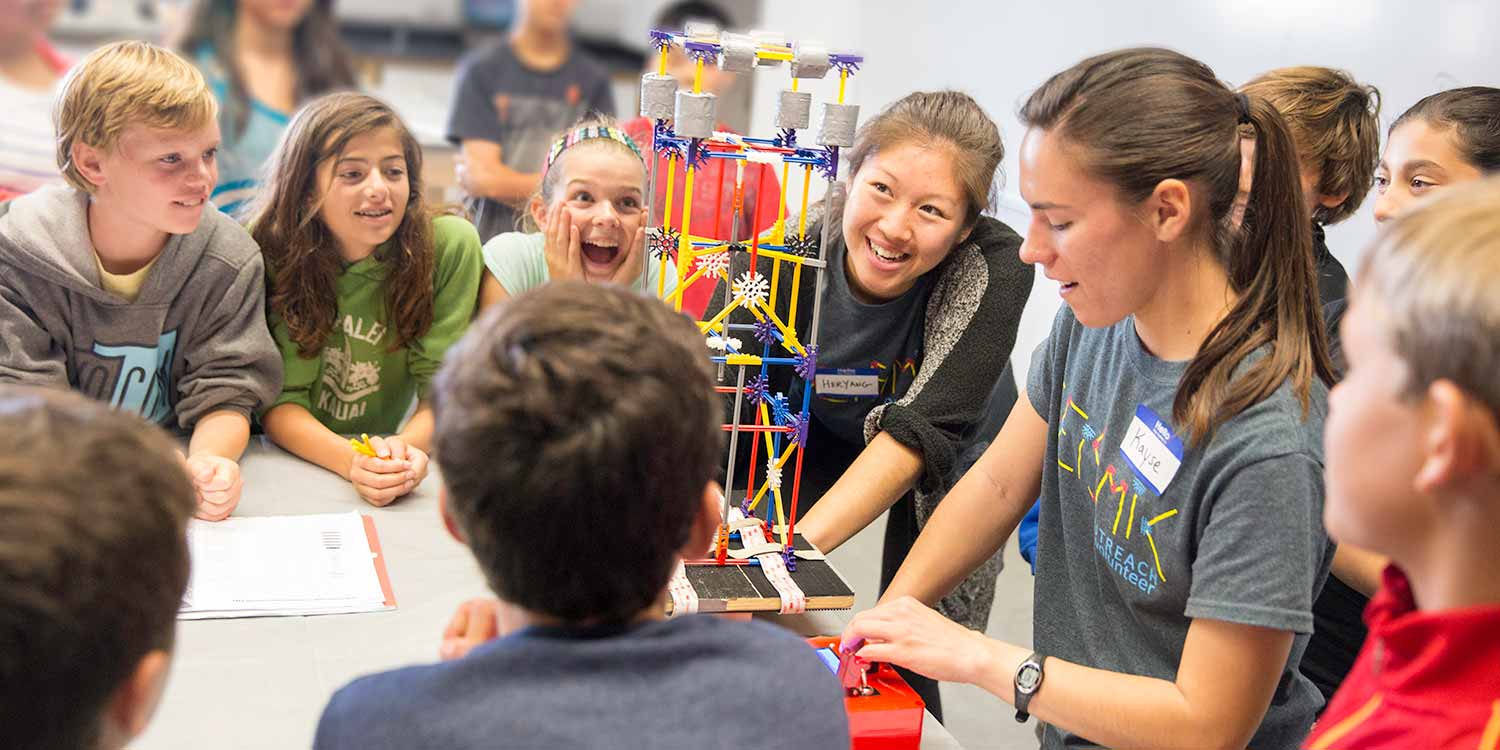
CLICK HERE TO VIEW HIS ARTICLE FOR MORE INFORMATION ON HOW TO EFFECTIVELY COLLABORATE AS AN EDUCATOR
Thank you for reading!
Follow me on Twitter at @IreneOrtiz001
The Importance of Web Filters
Irene Ortiz | May 29, 2023
Have you ever been connected to a school’s network or logged into your own district given email and tried to access any websites just to be met with an error or blocked message? When I was in high school, I could not access Youtube when I was logged into my school Gmail account and it was very frustrating when it came time to do research for projects. I did not understand why my schools growing up put so many limitations on the sites we could reach. I always assumed it was so we did not look up anything inappropriate, but a brief article by Nicole Bixler titled “The Benefits of Using a Web Filter for Digital Learning” introduced me to a few ways in which web filters actually support education.
While schools are required to have some sort of web filters to ensure that students are not accessing inappropriate or irrelevant content, it also protects students. Online, everyone is open to things such as data leaks, tracking, identity theft, harassment, and cyberbullying and young children are some of the biggest victims. In today’s age where everyone feels they need to post everything online, we often hear of young children being targeted online by their classmates or even strangers. By limiting their access to certain sites such as social media sites, students are less likely to engage in harmful internet behavior that can hurt themselves or others.
Bixler also discusses how web filtering also provides students with valuable skills such as research, data analysis, collaboration, and focus. With limits on sites that they can access, they are forced to do further research on their topics and look for their answers using sites they may not have thought to use if they had immediate access to sites like Youtube, Reddit, or Wikipedia. Not all schools block these sites or familiar sites, but having them blocked keeps learners from getting distracted from their tasks. When students are unable to find the answers to their questions, they ask questions to their peers or communicate with their teachers and work together to find a solution. Though they may not appreciate it now, web filtering when done correctly can actually teach students essential skills and online safety that they may not otherwise receive with full internet access.
CLICK HERE TO VIEW HER ARTICLE FOR MORE ON THE BENEFITS OF WEB FILTERS
Thank you for reading!
Follow me on Twitter at @IreneOrtiz001


